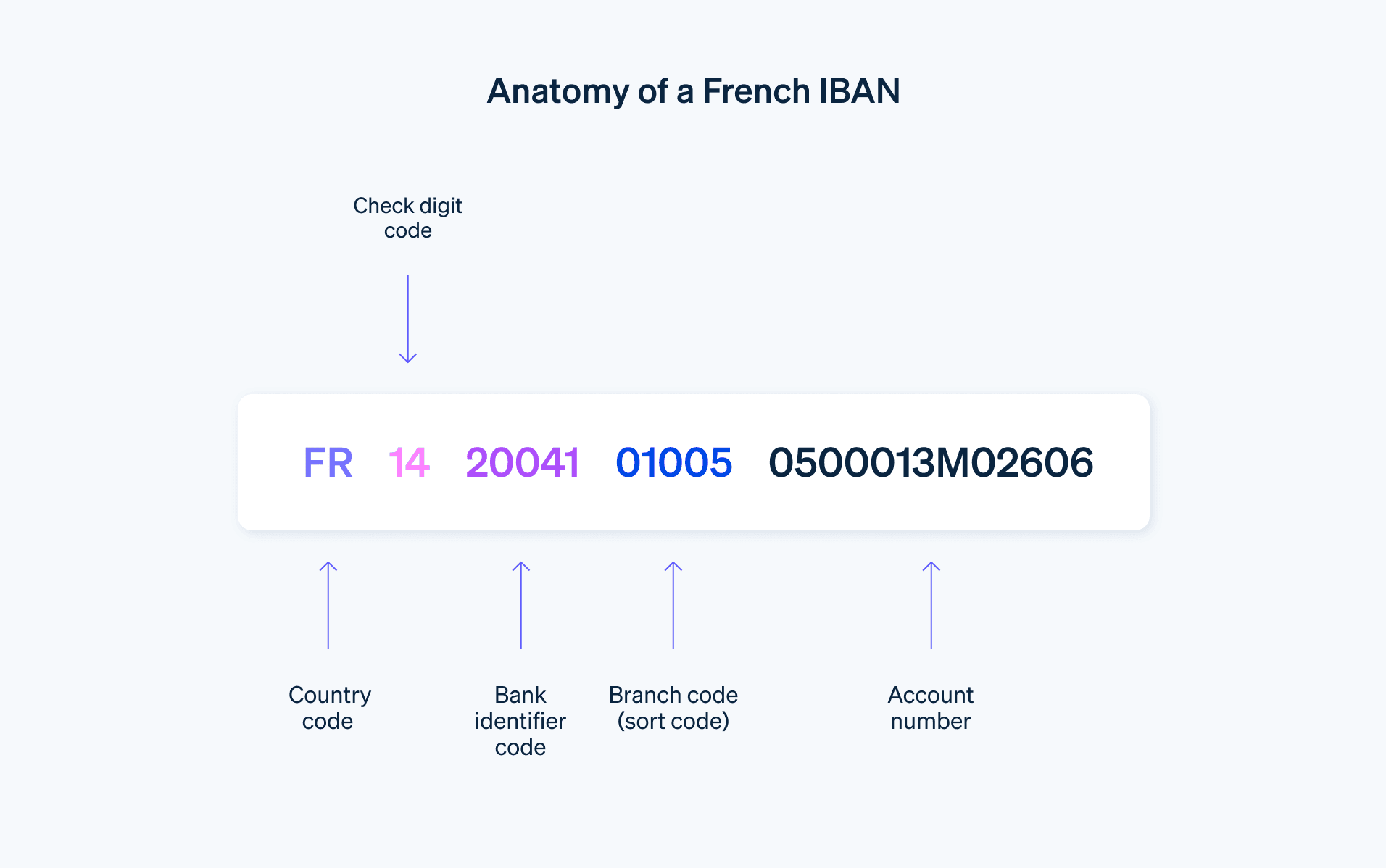IBANs are key to making the secure transfer of money in Europe and abroad easier. But what exactly is an IBAN, how can you find it, and what do all the letters and numbers in it mean? This article will explain everything you need to know, including how to identify your IBAN.
What’s in this article?
- What is an IBAN?
- What is an IBAN for?
- How is an IBAN formed?
- How many letters and numbers are there in a foreign IBAN?
- Where can you find your IBAN?
- How can you identify the bank the IBAN comes from?
What is an IBAN?
IBAN coordinates, IBAN code, IBAN key, etc. These terms all refer to the same thing: a standardized international bank account number—i.e., an alphanumeric code that allows you to identify a bank account anywhere in the world. The acronym stands for “International Bank Account Number.”
What is an IBAN for?
Knowing your IBAN is important if you want to send or receive national or international payouts. If you want to receive a payout from within France or from abroad, you need to send your IBAN key to the payout issuer. Similarly, you need the recipient’s IBAN if you want to send them a payout.
The codes are generally used within the Single Euro Payments Area (SEPA)—a unique euro payment area which consists of the 27 countries in the European Union, as well as Switzerland, Liechtenstein, Norway, Monaco, San Marino, Andorra, and the Vatican. Also note that the UK remains a member of SEPA following its departure from the European Union in 2020. All countries within SEPA use IBANs.
How is an IBAN formed?
In France, IBANs follow a format of exactly 27 characters. The first two letters correspond to the bank account’s country code. In France, this is “FR” (and in Germany, “DE” is used as its country code, while the UK uses “GB”). By looking at these two initial letters of each code, you can determine which country has issued the IBAN.
The two numbers following the country code correspond to the check key linked to the bank account. This key is important for IBAN verification.
The following 23 digits are the Basic Bank Account Number (BBAN), a number made up of the bank code, the routing number, the bank account number—and lastly—the bank details (“relevé d’identité bancaire,” or RIB, in French).
Bank codes in France are made up of five digits. The routing number is the same length.
The bank account number is usually 11 digits. For shorter account numbers, zeros are added to the beginning of the number to fill it up to 11 digits.
At the end of the IBAN is the RIB key, a two-digit code that is used to confirm that the bank account is actually valid.
Example of a French IBAN
FR76 3000 4028 3798 7654 3210 943
In the example above, the country code is “FR,” the check key is “76,” the bank code is “30004,” the routing number is “02837,” the bank account number is “98765432109,” and the RIB key is “43.”

How many letters and numbers are there in a foreign IBAN?
Be aware that each country structures its IBANs a little differently. Most foreign IBANs are made up of 14 to 34 characters. For example: DE89 3704 0044 0532 0130 00 for a German IBAN or GB29 NWBK 6016 1331 9268 19 for a British IBAN.
Where can you find your IBAN?
The easiest way to find your IBAN is to check your bank account statement, or RIB. You can find your RIB online in your bank account’s Customer Area, in your checkbook, or by going to a bank counter or ATM owned by your bank. Another option is to generate your IBAN using an online IBAN calculator with information you give it (bank, account number, etc.).
Make sure that you enter the IBAN carefully: an incorrect IBAN can invalidate your transaction if the bank details in question don’t exist, or it can send your payout to the wrong recipient if the bank details exist but aren’t those of the intended recipient. If this happens, you should contact your bank as quickly as possible to cancel the transaction in question.
How can you identify the bank the IBAN comes from?
It’s important to know the general format of an IBAN as well as its components in order to identify the corresponding bank. You can easily find out the bank an IBAN is linked to by looking at the characters following the check digits. Together, these characters make up the bank code, which identifies the banking institution corresponding to the IBAN in question.
Some bank codes are only made up of numbers, while others also contain letters. The length and composition of these codes vary from country to country. For instance, the bank code in the German IBAN example is made up of eight numbers, while the bank code in the British IBAN example is made up of four letters. The bank code “30004” in the French IBAN example “FR76 3000 4028 3798 7654 3210 943” corresponds to the bank BNP Paribas.
Here are the most up-to-date bank codes in France:
- BNP Paribas: 30004
- Crédit Agricole: 30006
- Société Générale: 30003
- Banque Populaire (BPCE): 10107
- Caisse d’Epargne (BPCE): 11315
- Crédit Mutuel: 10278
- La Banque Postale: 20041
- HSBC France: 30056
- Crédit du Nord: 30076
- Crédit Coopératif: 42559
The content in this article is for general information and education purposes only and should not be construed as legal or tax advice. Stripe does not warrant or guarantee the accurateness, completeness, adequacy, or currency of the information in the article. You should seek the advice of a competent attorney or accountant licensed to practice in your jurisdiction for advice on your particular situation.